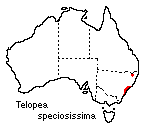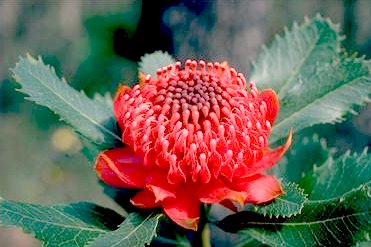| Telopea is an eastern Australian
genus of four species. Two are confined to New South Wales, one to Tasmania
and one extends from eastern Victoria into New South Wales. Telopea belongs
to the family, Proteaceae, which is predominantly Australian and southern
African in distribution and includes genera such as Grevillea, Banksia,
Macadamia and Hakea. Protea cynaroides, King Protea, is the official floral
emblem of the Republic of South Africa.
The Waratah is a stout, erect shrub
which may grow to 4 metres. The dark green leathery leaves, 13-25 cm in
length, are arranged alternately and tend to be coarsely toothed. The flowers
are grouped in rounded heads 7 to 10 cm in diameter surrounded by crimson
bracts, about 5 to 7 cm long. It flowers from September to November and
nectar-seeking birds act as pollinators. Large winged seeds are released
when the brown leathery pods split along one side.
 The
species is fairly widespread on the central coast and adjoining mountains
of New South Wales, occurring from the Gibraltar Range, north of Sydney,
to Conjola in the south. It grows mainly in the shrub understorey in open
forest developed on sandstone and adjoining volcanic formations, from sea
level to above 1000 metres in the Blue Mountains. Soils within its range
tend to be sandy and low in plant nutrients. Rainfall is moderately high.
Waratah plants resist destruction by bushfires, a natural element of their
habitat, by regenerating from the rootstock. Flowering recommences two
years after a moderate fire. The
species is fairly widespread on the central coast and adjoining mountains
of New South Wales, occurring from the Gibraltar Range, north of Sydney,
to Conjola in the south. It grows mainly in the shrub understorey in open
forest developed on sandstone and adjoining volcanic formations, from sea
level to above 1000 metres in the Blue Mountains. Soils within its range
tend to be sandy and low in plant nutrients. Rainfall is moderately high.
Waratah plants resist destruction by bushfires, a natural element of their
habitat, by regenerating from the rootstock. Flowering recommences two
years after a moderate fire.
The Waratah
is a spectacular garden subject in suitable soil and climate; it flowers
prolifically and tends to be long-lived. Failures can usually be attributed
to the effects of unsuitable soil conditions, aspect or climate. Seeds
should be sown in a coarse sandy medium and soon after germination the
seedlings should be transplanted into individual pots of similar soil.
Fresh seeds germinate readily but the seedlings are prone to the fungal
disease, 'damping off', which may be reduced by exposing the seedlings
to full light, except for the shading necessary after transplanting. Propagation
by cuttings is also possible. In the garden, plants should be grown in
lightly shaded to sunny positions in deep, well drained soil. They need
to be well watered until fully established but waterlogging must be avoided.
The Waratah
responds well to pruning which encourages flowering the following year,
and overcomes the natural tendency of the shrub to assume a straggly shape.
Some pruning is achieved by cutting flowers for decoration. It is a spectacular
cut flower and lasts well in water.
Flowers are usually crimson, but
a rare creamy white form, Telopea 'Wirrimbirra White', has been
cultivated successfully as a horticultural curiosity. Manipulated hybrids
of T. speciosissima have been produced combining the grandeur of
its flowers with the greater frost tolerance of other Telopea species.
Hybrids between T. speciosissima and the Braidwood Waratah, T.
mongaensis, have smaller flowers but are usually more floriferous with
a compact shape and attractive foliage. One of these hybrids is the registered
cultivar, Telopea 'Braidwood Brilliant', a spectacular garden plant
developed at the Australian National Botanic Gardens.
The Waratah occurs naturally in at
least ten national parks in the geological formation, know as the Sydney
Basin. Brisbane Water, Dharug and Macquarie Pass National Parks are among
the areas where this species is conserved. Waratahs are cultivated north
of Sydney and in the Dandenong Ranges, Victoria. They are grown in Israel,
New Zealand and Hawaii for the cut flower trade. It was introduced to England
in 1789 but cannot survive English winters out of doors, and it rarely
flowers in glasshouses. It is also cultivated
in California. |

 The
species is fairly widespread on the central coast and adjoining mountains
of New South Wales, occurring from the Gibraltar Range, north of Sydney,
to Conjola in the south. It grows mainly in the shrub understorey in open
forest developed on sandstone and adjoining volcanic formations, from sea
level to above 1000 metres in the Blue Mountains. Soils within its range
tend to be sandy and low in plant nutrients. Rainfall is moderately high.
Waratah plants resist destruction by bushfires, a natural element of their
habitat, by regenerating from the rootstock. Flowering recommences two
years after a moderate fire.
The
species is fairly widespread on the central coast and adjoining mountains
of New South Wales, occurring from the Gibraltar Range, north of Sydney,
to Conjola in the south. It grows mainly in the shrub understorey in open
forest developed on sandstone and adjoining volcanic formations, from sea
level to above 1000 metres in the Blue Mountains. Soils within its range
tend to be sandy and low in plant nutrients. Rainfall is moderately high.
Waratah plants resist destruction by bushfires, a natural element of their
habitat, by regenerating from the rootstock. Flowering recommences two
years after a moderate fire.